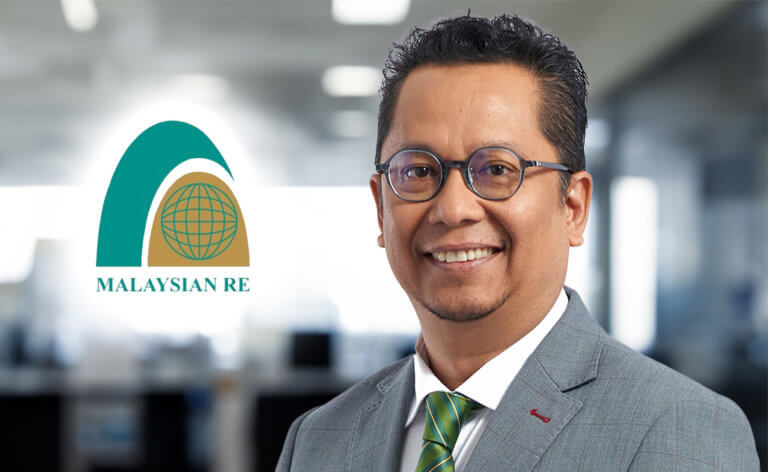Q&A: Sustainability considerations a key theme for Asean carriers, says Malaysian Re’s Azhari
September 27 2024 by Heather Ng
The Malaysian reinsurer’s president and CEO Ahmad Noor Azhari lays out the regional insurance landscape and charts the carrier’s strategic ambitions in an exclusive chat with IAN.
Can you provide an overview of the current state of the reinsurance market in South-East Asia? What are the key trends and developments you’ve observed in recent years?
The recent few years have been relatively quiet in terms of market-wide headline insured losses for all the individual countries in the region. Nonetheless, the markets were not spared from the (re)insurance market hardening globally in the last two years. Though the extent of price hikes varied from country to country and from client to client, some were more impacted than the other. The market globally has begun to soften since the beginning of the year.
Some of the observations on the key trends and developments within the region include:
Underwriting practices are increasingly incorporating climate change and sustainability considerations in risk selection and portfolio management. The adoption rates vary across countries, largely influenced by the net zero goals set by the local regulators.
“We will continue to play a positive role in support of green energy via the ASEAN Renewable Energy Pool which is focused on solar and onshore wind operational power plants.” Ahmad Noor Azhari, Malaysian Re
In Cambodia, new regulations have been introduced for lead and follow markets, specifically addressing capacity limitations which favours companies with a higher credit rating.
There is a notable trend in government-related construction projects, particularly those involving flood mitigation, where flood sub-limits are being imposed. Traditionally, construction projects in Malaysia did not have sub-limits for flooding. However, due to the nature and duration of these projects, the introduction of sub-limits is welcomed by insurers and reinsurers as it allows for better aggregate management.
How are climate change and the growing frequency/severity of natural disasters affecting the reinsurance market in the region?
On the buyers’ side, we are seeing greater interest and usage of cat models from established vendors like AIR, RMS to quantify the company’s nat cat exposure. Certain more sophisticated clients have even gone to the extent of mapping their individual policy level nat cat exposure data and incorporating nat cat accumulation exposure into their underwriting and risk-taking. In general, clients are buying more cat covers.
On the sellers’ side, reinsurers are seeking more granular exposure data from clients instead of zonal aggregate SI and adjusting their risk pricing accordingly.
Reinsurers may also reduce their exposure in high-risk areas, imposing stricter terms and conditions or even exclude certain types of risks, based on the data received from the client.
Additionally, there is a growing emphasis on ESG factors by reinsurers when making decisions by evaluating the sustainability practices of the company.
Looking ahead, what are the key priorities and focus areas for Malaysian Re in South-East Asia?
ESG is one of the areas of focus for Malaysian Re. We will continue to play a positive role in support of green energy via the ASEAN Renewable Energy Pool which is focused on solar and onshore wind operational power plants.
As a whole, we look forward to expanding our presence in the region and becoming a prominent player in the South-East Asia, not merely as a transactional capacity provider but rather a collaborative partner for the long term. We will continue to cultivate strategic and lasting relationships with our partners/clients across the region as well as work closely with the national reinsurers in the region for the betterment of the industry.
Malaysia, being our home market, will always be close to our hearts. It is our core and our backbone. With all the signs suggesting the market is firmly back in the right direction following the market corrections we have undertaken since the megaflood back in 2021, we can now look towards further to strengthen our position in the market. This includes enhancing our technical capabilities to better serve the growing needs of the market which include cyber, health and credit etc., as well as working closely with the regulators on market schemes and product innovations to close the protection gap for the benefit of all Malaysians, in particular the under-served segment.
As we chart our growth moving forward, our aim is to expand from being the national reinsurer for Malaysia to becoming a reinsurance partner of choice for our South-East Asia clients, an ASEAN reinsurer for ASEAN.
-
Allianz General | Allianz General combines innovative protection solutions while powering social good to lead Malaysian market
The insurer proactively addresses emerging risks and evolving customer protection needs while giving back to the community.
-
Sedgwick | Asia’s Energy Transformation – Balancing Growth, Risk and Renewables
Energy market presents unique risks, especially in a region which includes China and Japan as well as developing nations like Vietnam and the Philippines.
-
Beazley | Turbulent Waters: the maritime energy transition challenge
Businesses are facing a complex transition to non-carbon energy sources amid a push to achieve net-zero emissions for the marine sector by 2050.
-
Aon | Navigating shifts in the global and Asia insurance markets
Neelay Patel, Aon head of growth for Asia, says the market in Asia is at an ‘interesting stage of the cycle’.

